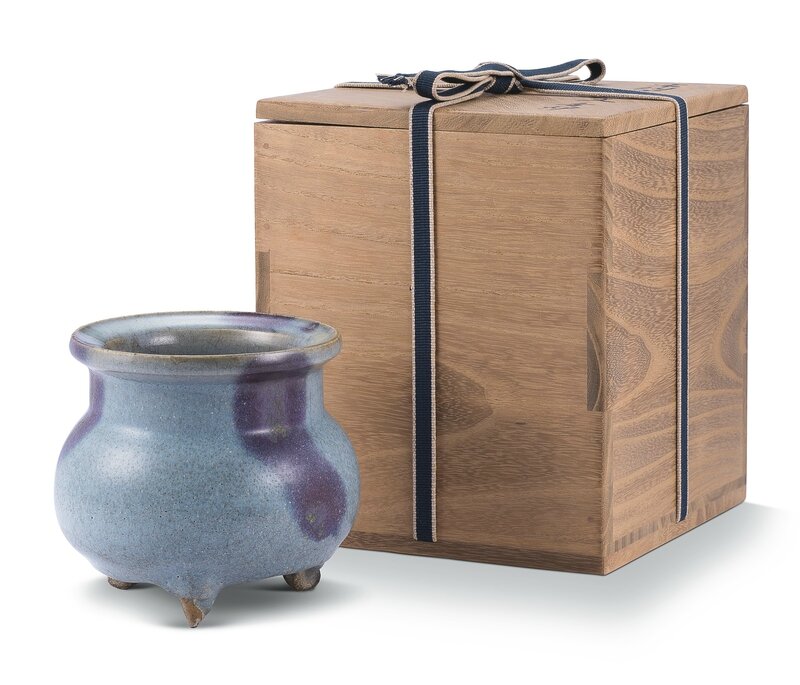An impressive 'Jun' purple-splashed, tripod incense burner, Song–Jin dynasty (960.1234)
Lot 527. An impressive 'Jun' purple-splashed, tripod incense burner, Song–Jin dynasty (960.1234). Estimate 550,000 — 750,000 HKD. Lot sold 625,000 HKD. Photo Sotheby's.
the compressed globular body raised on three short cabriole legs, the short broad neck culminating in a wide angled galleried rim, covered overall with a blue glaze accentuated with spontaneously splashed purple markings, save for the base and bottom of the interior left unglazed to reveal a buff-coloured stoneware body, Japanese wood box - 12.3 cm, 4 7/8 in.
Provenance: Collection of Aizaburo Iinuma, Tokyo.
Exhibited: Watashi no Atsumeta Yakimono Ten [Selected Ceramics Exhibition], The Museum of Modern Art Kamakura & Hayama, Kanagawa, 1970, no. 3.
Literature: Mayuyama: Seventy Years, Tokyo, 1976, pl. 407.
Japanese box with Hakogaki by Fujio Koyama (1900-75).
Notes: The present incense burner is an impressive and rare example of its type. While its form continues in the classic style of the Song period, its large size and splashes reveal the technical and stylistic developments of the time. Incense burners of this type were more commonly produced in smaller size; see a slightly smaller example, but with less prominent splashes, illustrated in John Ayers, The Baur Collection, vol. 1, Geneva, 1968, pl. A37; and another, but the splashes restricted to the globular body to create a two-toned effect with a lavender neck, published in Regina Krahl, Chinese Ceramics from the Meiyintang Collection, vol. 1, London, 1994, pl. 394.
Wares from the typesite Juntai in Yu county, Henan province, an area formerly known as Junzhou, are remarkable for their luscious thick glaze of intense colouration which can vary from light blue to deep turquoise blue. It was in the early twelfth century that potters started applying splashes of copper to the glaze before firing, resulting in patches of purple, lavender and tones of deep blue on the milky-blue primary glaze. The form of this incense burner derives from the archaic bronze liding, a ritual vessel from the Shang to Han dynasties (16th century BC-220 AD) and reflects the interest in antiquity amongst members of the educated elite. The literati of the day formed collections of ancient bronzes which were used only on special occasions to prevent them from wear and damage; thus contemporary vessels of bronze and ceramics based on antique models were commissioned.

/https%3A%2F%2Fprofilepics.canalblog.com%2Fprofilepics%2F1%2F0%2F100183.jpg)
/https%3A%2F%2Fstorage.canalblog.com%2F03%2F02%2F119589%2F96711876_o.jpg)
/https%3A%2F%2Fstorage.canalblog.com%2F11%2F31%2F119589%2F94773502_o.jpg)
/https%3A%2F%2Fstorage.canalblog.com%2F20%2F83%2F119589%2F94772815_o.jpg)
/https%3A%2F%2Fstorage.canalblog.com%2F26%2F72%2F119589%2F75604929_o.jpg)
/https%3A%2F%2Fstorage.canalblog.com%2F59%2F60%2F119589%2F26458628_o.jpg)




/image%2F1371349%2F20240227%2Fob_6e30af_tripod-incense-burner-in-celadon-glaze.jpg)
/http%3A%2F%2Fstorage.canalblog.com%2F30%2F61%2F119589%2F129473990_o.jpg)
/http%3A%2F%2Fstorage.canalblog.com%2F01%2F22%2F119589%2F129318352_o.jpg)
/http%3A%2F%2Fstorage.canalblog.com%2F26%2F73%2F119589%2F129274410_o.jpg)